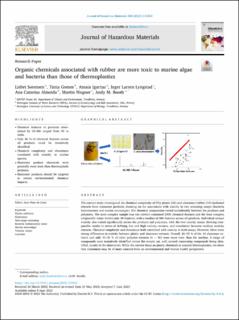| dc.contributor.author | Sørensen, Lisbet | |
| dc.contributor.author | Gomes, Tania | |
| dc.contributor.author | Igartua, Amaia | |
| dc.contributor.author | Lyngstad, Inger Larsen | |
| dc.contributor.author | Almeida, Ana Catarina | |
| dc.contributor.author | Wagner, Martin | |
| dc.contributor.author | Booth, Andy | |
| dc.date.accessioned | 2023-09-04T10:17:09Z | |
| dc.date.available | 2023-09-04T10:17:09Z | |
| dc.date.created | 2023-06-13T09:49:12Z | |
| dc.date.issued | 2023 | |
| dc.identifier.issn | 0304-3894 | |
| dc.identifier.uri | https://hdl.handle.net/11250/3087273 | |
| dc.description.abstract | The current study investigated the chemical complexity of fifty plastic (36) and elastomer/rubber (14) methanol extracts from consumer products, focusing on the association with toxicity in two screening assays (bacteria luminescence and marine microalgae). The chemical composition varied considerably between the products and polymers. The most complex sample (car tire rubber) contained 2456 chemical features and the least complex (disposable water bottle) only 39 features, with a median of 386 features across all products. Individual extract toxicity also varied significantly across the products and polymers, with the two toxicity assays showing comparable results in terms of defining low and high toxicity extracts, and correlation between medium toxicity extracts. Chemical complexity and abundance both correlated with toxicity in both assays. However, there were strong differences in toxicity between plastic and elastomer extracts. Overall, 86–93 % of the 14 elastomer extracts and only 33–36 % of other polymer extracts (n = 36) were more toxic than the median. A range of compounds were tentatively identified across the sample set, with several concerning compounds being identified, mostly in the elastomers. While the current focus on plastic chemicals is towards thermoplastics, we show that elastomers may be of more concern from an environmental and human health perspective. | en_US |
| dc.language.iso | eng | en_US |
| dc.publisher | Elsevier | en_US |
| dc.rights | Navngivelse 4.0 Internasjonal | * |
| dc.rights.uri | http://creativecommons.org/licenses/by/4.0/deed.no | * |
| dc.subject | Plastic additives | en_US |
| dc.subject | Elastomers | en_US |
| dc.subject | Non-target screening | en_US |
| dc.subject | Bacteria luminescence assay | en_US |
| dc.subject | Marine microalgae | en_US |
| dc.subject | Toxicity assays | en_US |
| dc.subject | Leachate | en_US |
| dc.title | Organic chemicals associated with rubber are more toxic to marine algae and bacteria than those of thermoplastics | en_US |
| dc.title.alternative | Organic chemicals associated with rubber are more toxic to marine algae and bacteria than those of thermoplastics | en_US |
| dc.type | Journal article | en_US |
| dc.type | Peer reviewed | en_US |
| dc.description.version | publishedVersion | en_US |
| dc.rights.holder | © 2023 The Author(s). Published by Elsevier Ltd. This is an open access article under the CC BY license (http://creativecommons.org/licenses/by/4.0/). | en_US |
| dc.source.volume | 458 | en_US |
| dc.source.journal | Journal of Hazardous Materials | en_US |
| dc.identifier.doi | 10.1016/j.jhazmat.2023.131810 | |
| dc.identifier.cristin | 2153994 | |
| dc.relation.project | Norges forskningsråd: 295174 | en_US |
| dc.source.articlenumber | 131810 | en_US |
| cristin.ispublished | true | |
| cristin.fulltext | original | |
| cristin.qualitycode | 2 | |

